Bangladesh
This article is about the People's Republic of
Bangladesh. For other uses, see Bangladesh
| People's Republic of Bangladesh
গণপ্রজাতন্ত্রী বাংলাদেশ
Gônoprojatontri Bangladesh |
||||||
|---|---|---|---|---|---|---|
|
||||||
| Anthem: Amar Shonar Bangla My Golden Bengal |
||||||
 |
||||||
| Capital (and largest city) |
Dhaka 23°42′N 90°21′E / 23.7°N 90.35°E |
|||||
| Official language(s) | Bengali | |||||
| Demonym | Bangladeshi | |||||
| Government | Parliamentary republic[1] | |||||
| - | President | Zillur Rahman | ||||
| - | Prime Minister | Sheikh Hasina Wazed | ||||
| - | Speaker | Ad.Abdul Hamid | ||||
| Independence | from Pakistan | |||||
| - | Declared | March 26, 1971 | ||||
| - | Victory Day | December 16, 1971 | ||||
| Area | ||||||
| - | Total | 147,570 km2 (94th) 55,599 sq mi |
||||
| - | Water (%) | 7.0 | ||||
| Population | ||||||
| - | 2009 estimate | 162,221,000[2] (7th) | ||||
| - | Density | 1,099.3/km2 (5th) 2,917.6/sq mi |
||||
| GDP (PPP) | 2009 estimate | |||||
| - | Total | $226.205 billion[3] (48th) | ||||
| - | Per capita | $1,398[3] (153rd) | ||||
| GDP (nominal) | 2008 estimate | |||||
| - | Total | $84.196 billion[3] (58th) | ||||
| - | Per capita | $690[4] (147th) | ||||
| Gini (2000) | 33.4 (medium) | |||||
| HDI (2007) | ▲ 0.543[5] (medium) (146th) | |||||
| Currency | Taka (BDT) |
|||||
| Time zone | BST (UTC+6) | |||||
| - | Summer (DST) | BDST (UTC+7) | ||||
| Drives on the | left | |||||
| Internet TLD | .bd | |||||
| Calling code | 880 | |||||
| 1 | Adjusted population, p.4, | |||||
The borders of present-day Bangladesh were established with the partition of Bengal and India in 1947, when the region became the eastern wing of the newly formed Pakistan. However, it was separated from the western wing by 1,600 km (994 mi) of Indian territory. Political and linguistic discrimination as well as economic neglect led to popular agitations against West Pakistan, which led to the war for independence in 1971 and the establishment of Bangladesh. After independence the new state endured famines, natural disasters and widespread poverty, as well as political turmoil and military coups. The restoration of democracy in 1991 has been followed by relative calm and economic progress.
Bangladesh is the seventh most populous country and is among the most densely populated countries in the world with a high poverty rate. However, per-capita (inflation-adjusted) GDP has more than doubled since 1975, and the poverty rate has fallen by 20% since the early 1990s. The country is listed among the "Next Eleven" economies. Dhaka, the capital, and other urban centers have been the driving force behind this growth.[6]
Geographically, the country straddles the fertile Ganges-Brahmaputra Delta and is subject to annual monsoon floods and cyclones. Bangladesh has the longest unbroken sea beach in the world in the Cox's Bazaar. The government is a parliamentary democracy. Bangladesh is a member of the Commonwealth of Nations, the OIC, SAARC, BIMSTEC, and the D-8. As the World Bank notes in its July 2005 Country Brief, the country has made significant progress in human development in the areas of literacy, gender parity in schooling and reduction of population growth.[7] However, Bangladesh continues to face a number of major challenges, including widespread political and bureaucratic corruption, economic competition relative to the world, serious overpopulation, widespread poverty, and an increasing danger of hydrologic shocks brought on by ecological vulnerability to climate change.
Contents[hide] |
History
Main articles: History of Bangladesh and History of Bengal

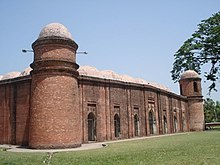
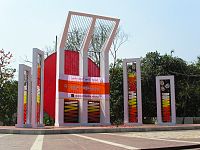
The kingdom of Gangaridai was formed from at least the seventh century BC, which later united with Bihar under the Magadha, Nanda, Mauryan and Sunga Empires. Bengal was later part of the Gupta Empire and Harsha Empire from the third to the sixth centuries CE. Following its collapse, a dynamic Bengali named Shashanka founded an impressive yet short-lived kingdom. Shashanka is considered the first independent king in the history of Bangladesh.
After a period of anarchy, the Buddhist Pala dynasty ruled the region for four hundred years, followed by a shorter reign of the Hindu Sena dynasty. Islam was introduced to Bengal in the twelfth century by Arab Muslim merchants and Sufi missionaries, and subsequent Muslim conquests helped spread Islam throughout the region.[10]
Bakhtiar Khilji, a Turkic general, defeated Lakshman Sen of the Sena dynasty and conquered large parts of Bengal in the year 1204. The region was ruled by dynasties of Sultans and land lords Bhuiyan for the next few hundred years. By the 16th century, the Mughal Empire controlled Bengal, and Dhaka became an important provincial centre of Mughal administration.
European traders arrived late in the 15th century, and their influence grew until the British East India Company gained control of Bengal following the Battle of Plassey in 1757.[11] The bloody rebellion of 1857, known as the Sepoy Mutiny, resulted in transfer of authority to the crown, with a British viceroy running the administration.[12] During colonial rule, famine racked the Indian subcontinent many times, including the Great Bengal famine of 1943 that claimed 3 million lives.[13]
20th century
Between 1905 and 1911, an abortive attempt was made to divide the province of Bengal into two zones, with Dhaka being the capital of the eastern zone.[14] When India was partitioned in 1947, Bengal was partitioned along religious lines (for the majority Muslims), with the western part going to India and the eastern part joining Pakistan as a province called East Bengal (later renamed East Pakistan), with its capital at Dhaka.[15]In 1950, land reform was accomplished in East Bengal with the abolishment of the feudal zamindari system.[16] However, despite the economic and demographic weight of the east, Pakistan's government and military were largely dominated by the upper classes from the west. The Bengali Language Movement of 1952 was the first sign of friction between the two wings of Pakistan.[17]
Dissatisfaction with the central government over economic and cultural issues continued to rise through the next decade, during which the Awami League emerged as the political voice of the Bengali-speaking population. It agitated for autonomy in the 1960s, and in 1966, its president Sheikh Mujibur Rahman was jailed; he was released in 1969, after an unprecedented popular uprising.
In 1970, a massive cyclone devastated the coast of East Pakistan, killing up to half a million people,[18] and the central government responded poorly. The Bengali population's anger was compounded when Sheikh Mujibur Rahman, whose Awami League won a majority in Parliament in the 1970 elections,[19] was blocked from taking office.
After staging compromise talks with Mujib, President Yahya Khan arrested him on the early hours of March 26, 1971, and launched Operation Searchlight,[20] a sustained military assault on East Pakistan. Yahya's methods were extremely bloody, and the violence of the war resulted in many civilian deaths .[21] Chief targets included intellectuals and Hindus, and about ten million refugees fled to neighbouring India.[22] Estimates of those massacred throughout the war range from three hundred thousand to 3 million.[23]
Before his arrest by the Pakistan Army, Sk. Mujibur Rahman formally declared the independence of Bangladesh and directed everyone to fight till the last soldier of the Pakistan army was evicted from East Pakistan. Awami League leaders set up a government-in-exile in Calcutta, India. The exile government formally took oath at Mujib Nagar in Kustia district of East Pakistan on April 14, 1971 with Tajuddin Ahmad as the first Prime Minister.
The Bangladesh Liberation War lasted for nine months. The Bangladesh Forces formed within 11 sectors led by General M.A.G. Osmani consisting of Bengali Regulars and Mukti Bahini conducted a massive guerilla war against the Pakistan Forces with all out support from the Indian Armed Forces. Jointly the Mitro Bahini achieved a decisive victory over Pakistan on December 16, 1971, with Indian Armed Forces taking over 90,000 prisoners of war.

A series of bloody coups and counter-coups in the following three months culminated in the ascent to power of General Ziaur Rahman, who reinstated multi-party politics & founded the Bangladesh Nationalist Party (BNP). Zia's rule ended when he was assassinated in 1981 by elements of the military. Bangladesh's next major ruler was General Hossain Mohammad Ershad, who gained power in a bloodless coup in 1982 and ruled until 1990, when he was forced to resign after a massive revolt of all major political parties and the public, joined with pressure from western donors (which was a major shift in international policy after the end of communism).
Since then, Bangladesh has reverted to a parliamentary democracy. Zia's widow, Khaleda Zia, led the Bangladesh Nationalist Party to parliamentary victory at the general election in 1991 and became the first female Prime Minister in Bangladesh's history. However, the Awami League, headed by Sheikh Hasina, one of Mujib's surviving daughters, clinched power at the next election in 1996 but lost to the Bangladesh Nationalist Party again in 2001.
On January 11, 2007, following widespread political unrest, a caretaker government was appointed to administer the next general election. The country had suffered from extensive corruption, disorder and political violence. The new caretaker government has made it a priority to root out corruption from all levels of government. To this end, many notable politicians and officials, along with large numbers of lesser officials and party members, have been arrested on corruption charges. The caretaker government held a fair and free election on December 29, 2008. Awami League's Sheikh Hasina won the elections with a landslide victory and took oath of Prime Minister on January 6, 2009.
Government and politics
Main article: Politics of Bangladesh
See also: Constitution of Bangladesh

| Anthem | Amar Shonar Bangla |
|---|---|
| Animal | Royal Bengal Tiger |
| Bird | Oriental Magpie Robin |
| Fish | Hilsa |
| Flower | White Water Lily |
| Fruit | Jackfruit |
| Sport | Hadudu |
| Calendar | Bengali calendar |
However the President's powers are substantially expanded during the tenure of a caretaker government, which is responsible for the conduct of elections and transfer of power. The officers of the caretaker government must be non-partisan and are given three months to complete their task. This transitional arrangement is an innovation that was pioneered by Bangladesh in its 1991 election and then institutionalized in 1996 through its 13th constitutional amendment.
The Constitution of Bangladesh was drafted in 1972 and has undergone fourteen amendments. The highest judicial body is the Supreme Court. Justices are appointed by the President. The judicial and law enforcement institutions are weak. Separation of powers, judicial from executive was finally implemented on the 1st of November, 2007. It is expected that this separation will make the judiciary stronger and impartial. Laws are loosely based on English common law, but family laws such as marriage and inheritance are based on religious scripts, and therefore differ between religious communities.
The two major parties in Bangladesh are the Bangladesh Awami League and the (Bangladesh Nationalist Party BNP). BNP is led by Khaleda Zia and finds its allies among Islamist parties like Jamaat-e-Islami Bangladesh and Islami Oikya Jot, while Sheikh Hasina's Awami League aligns with leftist and secularist parties. Hasina and Zia are bitter rivals who have dominated politics for over 15 years; each is related to one of the leaders of the independence movement. Another important player is the Jatiya Party, headed by former military dictator Ershad. The Awami League-BNP rivalry has been bitter and punctuated by protests, violence and murder. Student politics is particularly strong in Bangladesh, a legacy from the liberation movement era. Almost all parties have highly active student wings, and student leaders have been elected to the Parliament.
Two radical terrorist organizations, Jagrata Muslim Janata Bangladesh (JMJB) and Jama'atul Mujahideen Bangladesh (JMB), were banned in February 2005. Several small-scale bomb attacks taking place since 1999 have been blamed on those groups, and dozens of suspected members have been detained in security operations, including the heads of those two parties in 2006. The masterminds were tried and executed. The Bangladesh government won praise from world leaders, including Western leaders, for its strong anti-terrorist stance.
The January 22, 2007 election was postponed indefinitely and emergency law declared in January 11, 2007 as Army backed caretaker government of Fakhruddin Ahmed aimed to prepare a new voter list and crack down on corruption. They also assisted the interim Government of Bangladesh in a drive against corruption, which resulted in Bangladesh's position in the Transparency International's Corruption Index changed from the very bottom, where they had been for 3 year in a row, to 147th in just 1 year.
A large alliance led by the Bangladesh Awami League won the December 29, 2008 poll, in a landslide victory. They got 230 seats among 300 seats in the parliament. On 31 July 2009 Prime Minister Sheikh Hasina expanded the Bangladeshi cabinet to bring the total size to 44.
Foreign policy and military
Main articles: Foreign relations of Bangladesh
and Military of Bangladesh
Bangladesh pursues a moderate foreign policy that places heavy
reliance on multinational diplomacy, especially at the United Nations.
In 1974 Bangladesh joined both the Commonwealth of Nations and the United Nations and has since been elected to serve two
terms on the Security Council in
1978–1979 and 2000–2001. In the 1980s, Bangladesh played a lead role in
founding the South Asian
Association for Regional Cooperation (SAARC) in order to expand
relations with other South Asian states. Since the founding of SAARC
1985, a Bangladeshi has held the post of Secretary General on two
occasions.Bangladesh's most important and complex foreign relationships are with India. These relationships are informed by historical and cultural ties and form an important part of the domestic political discourse.
Bangladesh's relationship with India began on a positive note because of India's assistance in the independence war and reconstruction. Throughout the years, relations between both countries have fluctuated for a number of reasons. A major source of tension between Bangladesh and India is the Farakka Dam. In 1975, India constructed a dam on the Ganges River 11 miles (18 km) from the Bangladeshi border. Bangladesh alleges that the dam diverts much needed water from Bangladesh and adds a man-made disaster to the country already plagued by natural disasters. The dam also has terrible ecological consequences. On the other hand, India has voiced concerns about anti-Indian separatists and Islamic militants allegedly being harboured across their 2,500-mile (4,000 km) border, as well as the flow of illegal migrants, and is building a fence along most of it.But at the 2007 SAARC meeting both nations pledged to work cooperatively on security, economic and border issues.
The current strength of the army is around 200,000 including reservists, the air force 22,000, and navy 14,950. In addition to traditional defense roles, the military has been called on to provide support to civil authorities for disaster relief and internal security during periods of political unrest. Bangladesh is not currently active in any ongoing war, but it did contribute 2,300 troops to the coalition that fought in Operation Desert Storm in 1991 and Bangladesh is consistently a top contributor to UN peacekeeping forces around the world. As of May 2007, Bangladesh had major deployments in Democratic Republic of Congo, Liberia, Sudan, Timor-Leste and Côte d'Ivoire.. Presently Bangladesh is the 2nd largest troop contributor country to the UN.
Bangladesh enjoys relatively warm ties with the People's Republic of China which has, particularly in the past decade, increased economic cooperation with the South Asian nation. Between 2006 and 2007, trade between the two nations rose by 28.5% and there have been agreements to grant various Bangladeshi commodities tariff-free access to the Chinese market. Cooperation between the Military of Bangladesh and the People's Liberation Army is also increasing, with joint military agreements signed and Bangladesh procuring Chinese arms which range from small arms to large naval surface combatants such as the Chinese Type 053H1 Missile Frigate.
Divisions, districts, and upazilas
Main articles: Divisions of Bangladesh, Districts of Bangladesh, and Upazilas of Bangladesh

Divisions are subdivided into districts (zila). There are 64 districts in Bangladesh, each further subdivided into upazila (subdistricts) or thana. The area within each police station, except for those in metropolitan areas, is divided into several unions, with each union consisting of multiple villages. In the metropolitan areas, police stations are divided into wards, which are further divided into mahallas. There are no elected officials at the divisional, district or upazila levels, and the administration is composed only of government officials. Direct elections are held for each union (or ward), electing a chairperson and a number of members. In 1997, a parliamentary act was passed to reserve three seats (out of twelve) in every union for female candidates.
Dhaka is the capital and largest city of Bangladesh. Other major cities include Chittagong, Khulna, Rajshahi, Sylhet, Barisal, Bogra, Comilla, Mymensingh and Rangpur. These cities have mayoral elections, while other municipalities elect a chairperson. Mayors and chairpersons are elected for a span of five years.
Geography and climate
Main article: Geography of Bangladesh




In south east Bangladesh experiments have been done since the sixties to 'build with nature'. By implementing cross dams, the natural accretion of silt has created new land. With Dutch funding, the Bangladeshi government began to help develop this new land in the late 1970s. The effort has since become a multiagency operation building roads, culverts, embankments, cyclone shelters, toilets and ponds, as well as distributing land to settlers. By fall 2010, the program will have allotted some 27,000 acres (10,927 ha) to 21,000 families.
The highest point in Bangladesh is in Mowdok range at 1,052 m (3,451 ft) in the Chittagong Hill Tracts to the southeast of the country.
Straddling the Tropic of Cancer, Bangladeshi climate is tropical with a mild winter from October to March, a hot, humid summer from March to June. A warm and humid monsoon season lasts from June to October and supplies most of the country's rainfall. Natural calamities, such as floods, tropical cyclones, tornadoes, and tidal bores occur almost every year, combined with the effects of deforestation, soil degradation and erosion. Cox's Bazar, south of the city of Chittagong, has a beach that stretches uninterrupted over 120 kilometres (75 mi).
In September 1998, Bangladesh saw the most severe flooding in modern world history. As the Brahmaputra, Ganges and Meghna spilt over and swallowed 300,000 houses, 9,700 kilometres (6,027 mi) of road and 2,700 kilometres (1,678 mi) of embankment 1,000 people were killed and 30 million more were made homeless with 135,000 cattle killed, 50 square kilometres (19.3 sq mi) of land destroyed and 11,000 kilometres (6,835 mi) of roads damaged or destroyed. Two-thirds of the country was underwater. There were several reasons for the severity of the flooding. Firstly, there were unusually high monsoon rains. Secondly, the Himalayas shed off an equally unusually high amount of melt water that year. Thirdly, trees that usually would have intercept rain water had been cut down for firewood or to make space for animals.
Bangladesh is now widely recognized to be one of the countries most vulnerable to climate change. Natural hazards that come from increased rainfall, rising sea levels, and tropical cyclones are expected to increase as climate change, each seriously affecting agriculture, water & food security, human health and shelter. It is believed that in the coming decades the rising sea level alone will create more than 20 million climate refugees.
Flora and fauna
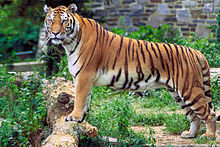
Economy
Main article: Economy of Bangladesh

Jute was once the economic engine of the country. Its share of the world export market peaked in the Second World War and the late 1940s at 80% and even in the early 1970s accounted for 70% of its export earnings. However, polypropylene products began to substitute for jute products worldwide and the jute industry started to decline. Bangladesh grows very significant quantities of rice (chaul), tea (Cha) and mustard.
Although two-thirds of Bangladeshis are farmers, more than three quarters of Bangladesh’s export earnings come from the garment industry, which began attracting foreign investors in the 1980s due to cheap labour and low conversion cost. In 2002, the industry exported US$5 billion worth of products.
The industry now employs more than 3 million workers, 90% of whom are women. A large part of foreign currency earnings also comes from the remittances sent by expatriates living in other countries.

Bashundhara City, the largest shopping mall
in South
Asia
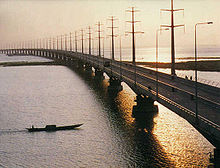
Despite these hurdles, the country has achieved an average annual growth rate of 5% since 1990, according to the World Bank. Bangladesh has seen expansion of its middle class, and its consumer industry has also grown. In December 2005, four years after its report on the emerging "BRIC" economies (Brazil, Russia, India, and China), Goldman Sachs named Bangladesh one of the "Next Eleven," along with Egypt, Indonesia, Vietnam and seven other countries. Bangladesh has seen a dramatic increase in foreign direct investment.
A number of multinational corporations and local big business houses such as Beximco, Square, Akij Group, Ispahani, Navana Group, Transcom Group, Habib Group, KDS Group and multinationals such as Unocal Corporation and Chevron, have made major investments, with the natural gas sector being a priority. In December 2005, the Central Bank of Bangladesh projected GDP growth around 6.5%.
One significant contributor to the development of the economy has been the widespread propagation of microcredit by Muhammad Yunus (awarded the Nobel peace prize in 2006) through the Grameen Bank. By the late 1990s, Grameen Bank had 2.3 million members, along with 2.5 million members of other similar organisations.
In order to enhance economic growth, the government set up several export processing zones to attract foreign investment. These are managed by the Bangladesh Export Processing Zone Authority.
Demographics
Main articles: Demographics of Bangladesh and Education in Bangladesh
See also: Bengali people


Bangladesh has the highest population density in the world, excluding a handful of city-states and small countries such as Bahrain. Bangladesh's population growth was among the highest in the world in the 1960s and 1970s, when the country grew from 50 to 90 million, but with the promotion of birth control in the 1980s, the growth rate slowed. The population is relatively young, with the 0–25 age group comprising 60%, while 3% are 65 or older. Life expectancy is 63 years for both males and females.
The majority ethnic group of Bangladesh are the Bengali people, comprising 98% of the population.[68] The remainder are mostly Bihari migrants and indigenous tribal groups. There are thirteen tribal groups located in the Chittagong Hill Tracts, the most populous of the tribes are the Chakmas. The region has been a source of ethnic tension since the inception of Bangladesh.
The largest tribal groups outside the Hill Tracts are the Santhals and the Garos (Achiks). There are also Kaibartta, Meitei, Mundas, Oraons, and Zomi ethnic groups. Human trafficking has been a lingering problem in Bangladesh and illegal immigration has remained a cause of friction with Burma and India.
The official and most widely used language in Bangladesh, as in West Bengal, is Bengali or Bangla, an Indo-Aryan language of Sanskrit origin with its own script. English is used as second language among the middle and upper classes and in higher education. Since a President Order in 1987, Bengali is used for all official correspondence except those that are to foreign recipients.
Health and education levels have recently improved as poverty levels have decreased. Most Bangladeshis are rural, living on subsistence farming. Health problems abound, ranging from surface water contamination, to arsenic contamination of groundwater,[75] and diseases including malaria, leptospirosis and dengue. The literacy rate in Bangladesh is approximately 41%.[76] There is gender disparity, though, as literacy rates are 50% among men and 31% among women, according to a 2004 UNICEF estimate.[77] Literacy has gone up due to many programmes introduced in the country. Among the most successful ones are the Food for education (FFE) programme introduced in 1993,[78] and a stipend programme for women at the primary and secondary levels.[79]
Religion
Main articles: Religion in Bangladesh, Islam in Bangladesh, Hinduism in Bangladesh, Christianity in Bangladesh, and Buddhism in Bangladesh
The major religion practiced in Bangladesh is Islam (89.7%) and a sizable minority adheres to Hinduism (9.2%).[80]
About 97% of the Muslims are Sunni while over 3% are Shi'a. Ethnic Biharis
are predominantly Shia Muslims. Other
religious groups include Buddhists (0.7%, mostly Theravada),
Christians (0.3%, mostly of the Roman Catholic denomination), and Animists
(0.1%).Bangladesh ranks fourth after Indonesia, Pakistan, and India by the number of Muslims, with over 130 million. Islam is the state religion of Bangladesh, but other religions may also be practiced in harmony. The United Nations has recognised the country mainly as a moderate Muslim democratic country.
Culture
Main article: Culture of Bangladesh
See also: Public holidays in Bangladesh,
Sport in Bangladesh, and Music of Bangladesh
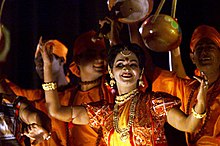
The musical tradition of Bangladesh is lyrics-based (Baniprodhan), with minimal instrumental accompaniment. The Baul tradition is a unique heritage of Bangla folk music, and there are numerous other musical traditions in Bangladesh, varying from one region to region. Gombhira, Bhatiali, Bhawaiya are a few of the better-known musical forms. Folk music of Bengal is often accompanied by the ektara, an instrument with only one string. Other instruments include the dotara, dhol, flute, and tabla. Bangladesh also has an active heritage in North Indian classical music. Similarly, Bangladeshi dance forms draw from folk traditions, especially those of the tribal groups, as well as the broader Indian dance tradition.

The culinary tradition of Bangladesh has close relations to Indian and Middle Eastern cuisine as well as having its own unique traits. Rice, and curry are traditional favourites. Bangladeshis make distinctive sweetmeats from milk products, some common ones being Rôshogolla, chômchôm and kalojam.
The shari (shaŗi) is by far the most widely worn dress by Bangladeshi women. Dhaka in particular is renowned for producing saris from exquisite Jamdani muslin. The salwar kameez (shaloar kamiz) is also quite popular, and in urban areas some women wear Western attire. Among men, Western attire is more widely adopted. Men also wear the kurta-paejama combination, often on religious occasions, and the lungi, a kind of long skirt.
The two Eids, Eid ul-Fitr and Eid ul-Adha are the largest festivals in the Islamic calendar. The day before Eid ul-Fitr is called Chãd Rat (the night of the moon), often celebrated with firecrackers. Other Muslim holidays are also observed. Major Hindu festivals are Durga Puja, Kali puja and Saraswati Puja. Buddha Purnima, which marks the birth of Gautama Buddha, is one of the most important Buddhist festivals while Christmas, called Bôŗodin (Great day) in Bangla is celebrated by the minority Christian population. The most important secular festival is Pohela Baishakh or Bengali New Year, the beginning of the Bengali calendar. Other festivities include Nobanno, Poush parbon (festival of Poush) and observance of national days like Shohid Dibosh.
Sports
Main article: Sports in Bangladesh












